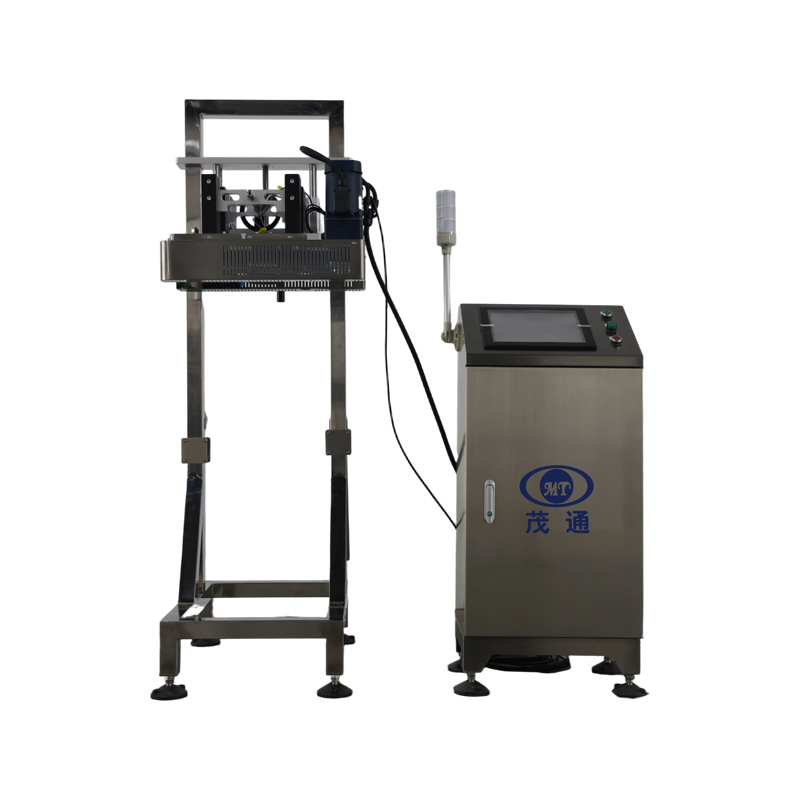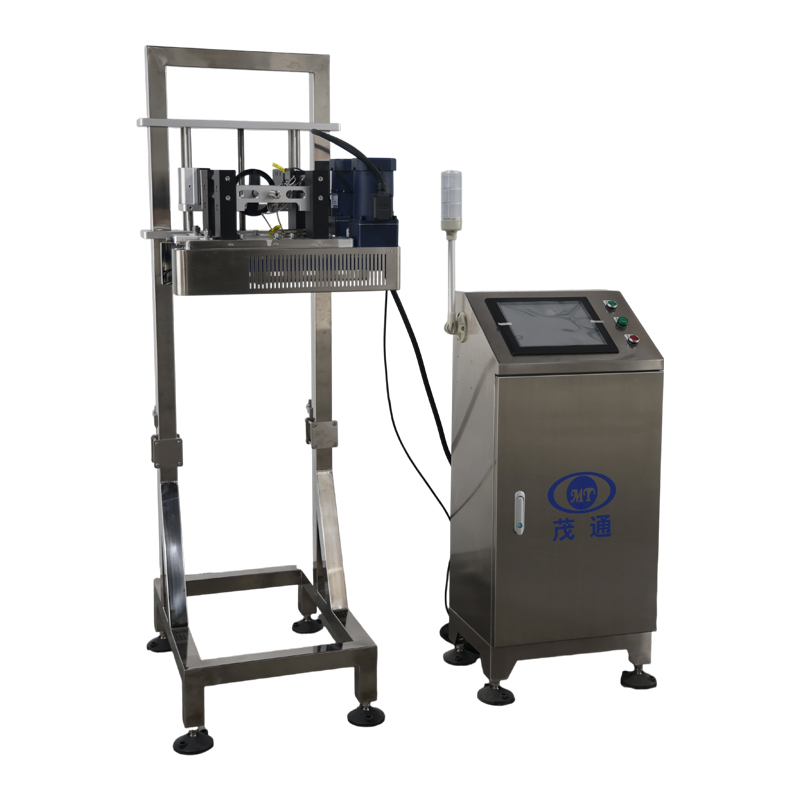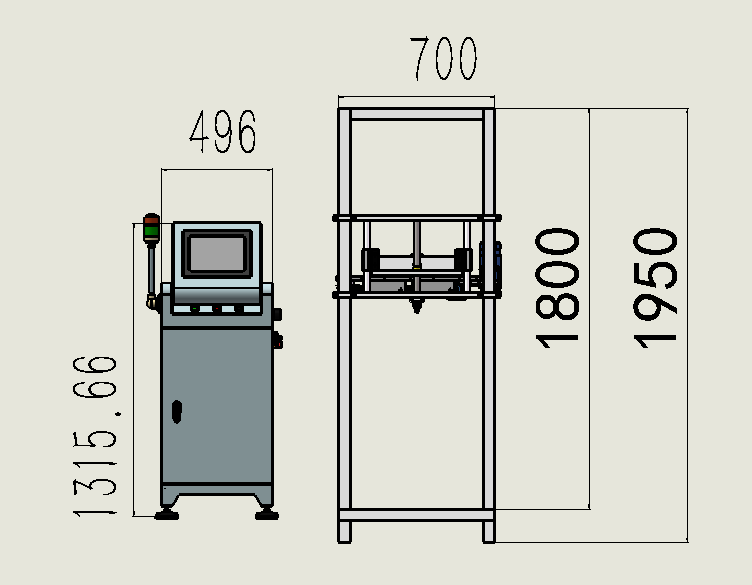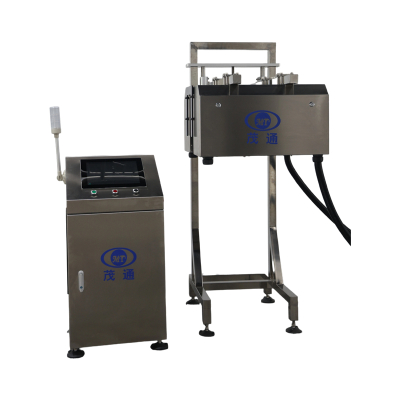Vision Pressure Solution for Cans
1.Non-contact detection, fast detection, high accuracy
2.Dynamically realize the detection of different production line speed
3.Main engine sealing design, manufacture, anti fog, waterproof, drip, environmental adaptability
4.The hardware circuit is adopted, and the embedded operating system is adopted to ensure stable operation for a long time
5.Sound,light, alarm, and automatically reject substandard containers
6.Big screen Chinese display, LED backlit night crystal, clear and bright handwriting, man-machine dialogue mode operation
7.High performance price ratio
1. Performance Description
The MT-YLG-XL-C0-04 is a fully automated pressure inspection system designed for high-speed production lines, with a capacity of up to 1,200 cans per minute. Using a contact-based online detection method, it accurately measures internal container pressure with stable and reliable data output. The system’s precision surpasses both domestic and international standards. Its core innovation is the belt squeeze detection technology, developed through more than three years of research and refinement. During operation, products are conveyed on a flexible belt, where side-mounted sensors capture pressure data. The controller converts these readings into digital signals, which are analyzed to provide a precise evaluation of container pressure and overall quality.
2. Applicable Inspection Objects
Aluminum cans filled with liquid nitrogen
PE/PP plastic bottles containing gas or steam
Other gas-filled containers (excluding CO₂)
3. Inspection Functions
Internal pressure detection
Missing lid detection
Inverted can detection
Blocked can detection
Automatic rejection of defective products based on user-defined thresholds
4. Performance and Parameters
Adaptive line speed tracking – automatically stops when the production line halts, preventing burst risks caused by idling.
Inspection speed: >1,200 cans/minute.
Supports both high- and low-pressure inspection.
Static accuracy: ±0.01 MPa.
Dynamic accuracy: ±0.02 MPa.
Resistant to high-speed impact.
User-friendly HMI operation.
Real-time display and monitoring of rejection data.
Visual alarm system for abnormal impact.
Chinese language interface.
Proprietary Maotong DSP digital signal processing algorithm.
24/7 remote technical support.
Continuous rejection shutdown protection.
5. Detection Accuracy
Detection Range: 0.08 – 0.5 MPa
Accuracy: better than 0.01 MPa
(Note: excessive vertical vibration of the conveyor chain may affect accuracy)Rejection Rate: ≥99.99%
False Rejection Rate: ≤0.01%
6. Extrusion Detection Principle
At the system’s inlet, a guide mechanism applies pre-squeezing to establish baseline pressure. If a container has a leak, the system allows this pressure to dissipate as much as possible before measuring the residual pressure at the outlet. For intact products, pressure variation remains minimal; however, defective containers show significant deviations. This principle ensures accurate identification of leaks and poor sealing performance.
7. Equipment detection principle
When a product passes the belt, it passes the positioning sensor, which detects its arrival and records the product's identification number and the current encoder signal through the control unit. The positioning sensor triggers the force sensor to measure the instantaneous pressure exerted by the product against the belt. This pressure data is then transmitted to the Maotong signal processing board via the network. The signal processing board processes and analyzes the received pressure data, transmitting the results to both the human-machine interface for dynamic display and the control unit. Upon receiving a rejection signal, the control unit notifies the rejector to remove the product with the corresponding identification number that fails the pressure requirement.
II. Equipment Installation
1. Equipment Loading, Unloading, and Storage
During transportation, the equipment must be secured and packaged, with particular attention to preventing the sensor from being subjected to pressure or tension. The exterior of the equipment must be wrapped with moisture-proof, impact-resistant material to prevent scratches, dents, and moisture. The equipment must be secured to the transport vehicle to prevent damage during movement. When unloading the equipment, use specialized loading equipment and ensure that the equipment is securely mounted on the loading equipment to prevent slipping. During use and storage, the ambient environment must meet certain requirements: relative humidity should be between 10% and 80%, and temperature between 0°C and 50°C.
2. Installation Specifications
2.1. Ensure the equipment is installed on a level surface, with the clamping conveyor belt aligned parallel to the product’s bottom conveyor belt.
2.2. Before powering on, check all cable connections to confirm they are secure, and verify proper grounding of the control cabinet.
2.3. Power supply requirements: Single-phase AC 220V, 50Hz, total power 250W.
2.4. Compressed air requirements: 4–8 bar, with quality conforming to industry standards.
2.5. For optimal testing accuracy, products should be inspected after cooling. The equipment must be installed on a straight conveyor section of 1.5–2 meters.
3. Equipment Structure and Appearance
3.1. Dimensions: 600 mm × 1000 mm × 1700 mm
3.2. Frame: 304 stainless steel, mounted on conveyor
3.3. Net Weight: approx. 100 kg
III. Safe Operation Guidelines
Before operating this equipment, observe the following safety rules:
3.1. Operation is permitted only for personnel with basic training.
3.2. Maintenance may only be carried out by professionally trained technicians.
3.3. Ensure all warning labels and protective devices are properly installed before use.
3.4. Do not run the machine with the cover open. The cover should only be opened after power and compressed air have been completely shut off.
3.5. Keep hands away from the reject cylinder’s connecting rod during operation.
3.6. Do not block or touch the photoelectric sensor during operation to avoid false triggering, malfunction, or injury.
3.7. Never disconnect electrical connections while the equipment is powered on, to prevent damage to components.
3.8. During servicing, clearly tag the equipment with warning signs to prevent accidental operation.
3.9. Ensure both the equipment and any external devices are powered off before connecting. Power should only be restored once connections are complete.
3.10. As the electronic components are static-sensitive, the frame and control cabinet must be reliably grounded.
IV. Commercial Terms
Delivery Location: Purchaser’s production site.
Warranty: 12 months from acceptance date, not exceeding 14 months from shipment date.
Post-warranty service: For two years after the warranty expires, only engineer travel costs and spare parts are chargeable.
Preventive Maintenance: Two engineer visits per year (two days each). Only spare parts will be billed. Purchaser must notify the supplier at least two weeks in advance via fax.
Software: Free lifetime software upgrades provided, without hardware modifications.
Service Response: Upon receipt of written service request, the supplier will arrive at the purchaser’s production site in mainland China within 72 hours.











